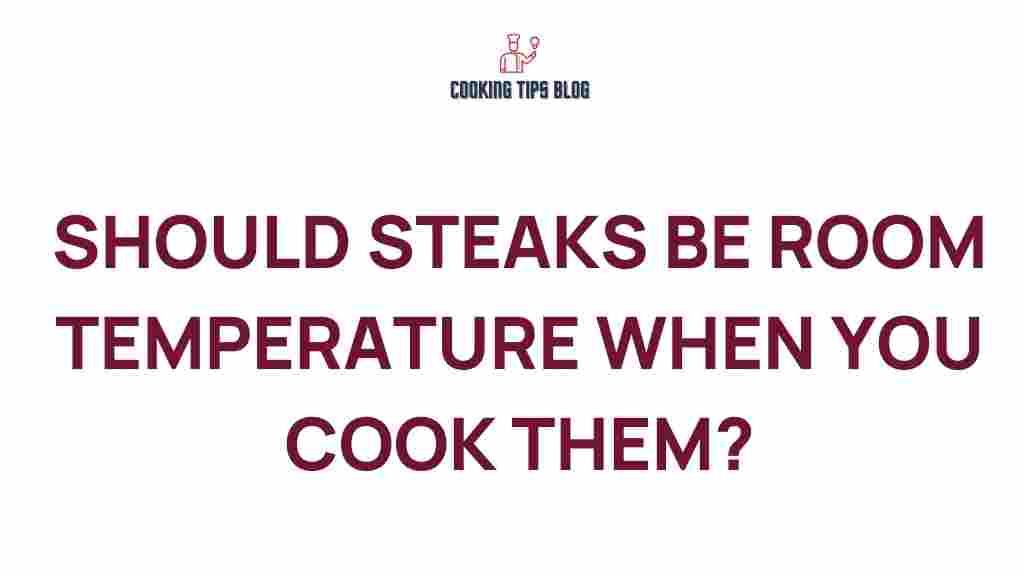The Secret to Perfect Steaks: Should They Be Room Temperature?
Steaks are a beloved dish across the globe, cherished for their rich flavor and succulent texture. Whether you prefer yours rare, medium rare, or well done, achieving the perfect steak requires a combination of quality ingredients and proper cooking techniques. One question that often arises among steak enthusiasts is whether steaks should be at room temperature before cooking. In this article, we will delve into the reasons behind this practice, the benefits it brings, and how to achieve the perfect steak every time.
Understanding the Science Behind Room Temperature Steaks
When it comes to cooking steaks, temperature plays a crucial role. Here’s why starting with room temperature steaks can make a difference:
- Even Cooking: Steaks taken directly from the refrigerator are cold in the center. This can lead to uneven cooking, where the outside cooks faster than the inside, often resulting in a steak that’s overcooked on the exterior and undercooked in the center.
- Better Searing: For a beautiful crust, steaks need to be seared at high temperatures. Cold steaks lower the cooking surface temperature, preventing the Maillard reaction—the chemical reaction that creates that delicious crust—from occurring efficiently.
- Juiciness: Allowing steaks to reach room temperature helps retain moisture. When cold steaks are cooked, the muscle fibers contract quickly, leading to moisture loss. This results in a drier steak.
How to Prepare Steaks for Cooking
To ensure your steaks reach the optimal temperature before cooking, follow these steps:
- Select Quality Steaks: Choose high-quality cuts such as ribeye, filet mignon, or sirloin. Look for marbling, which indicates tenderness and flavor.
- Remove Steaks from the Refrigerator: Take your steaks out of the refrigerator about 30-60 minutes before cooking. This allows them to warm up to room temperature.
- Season Generously: Use salt and pepper to season your steaks. Salt not only enhances flavor but also helps to draw out moisture, creating a better crust.
- Pat Dry: Before cooking, pat the steaks dry with paper towels. This step is crucial for achieving a nice sear.
Cooking Methods for Perfect Steaks
Now that your steaks are prepped, it’s time to cook them. Here are a few popular methods:
Grilling
Grilling is one of the most popular methods for cooking steaks. Here’s how to do it:
- Preheat your grill to high heat.
- Place the steaks on the grill, ensuring they are not crowded.
- Cook for 4-6 minutes on one side, then flip and cook for an additional 4-6 minutes, depending on your desired doneness.
- Use a meat thermometer to check for doneness: 130°F for medium rare, 140°F for medium.
- Let the steaks rest for about 5-10 minutes before cutting into them.
Pan-Seering
If you prefer cooking indoors, pan-searing is an excellent option:
- Heat a heavy skillet, preferably cast iron, over high heat.
- Add a tablespoon of oil with a high smoke point (like canola or grapeseed).
- Once the oil is shimmering, carefully add the steaks.
- Cook for 3-5 minutes on each side, depending on the thickness.
- For added flavor, consider basting with butter and herbs during the last minute of cooking.
Oven Finish
For thicker cuts, a combination of searing and finishing in the oven can yield perfect results:
- Preheat your oven to 400°F (200°C).
- Sear the steaks in a hot skillet for 2-3 minutes on each side.
- Transfer the skillet to the preheated oven and cook until the desired doneness is reached.
Troubleshooting: Common Mistakes When Cooking Steaks
Even the most experienced cooks can encounter challenges when preparing steaks. Here are some common mistakes and how to avoid them:
- Using a Cold Steak: As discussed, cooking a cold steak can lead to uneven cooking and a less desirable texture.
- Overcrowding the Pan or Grill: Placing too many steaks in one cooking surface can lower the temperature, preventing a proper sear.
- Skipping the Resting Period: Allowing your steak to rest after cooking is essential. It helps the juices redistribute, resulting in a more flavorful and juicy steak.
- Not Using a Thermometer: Relying solely on time for cooking can lead to over or undercooked steaks. A meat thermometer is your best friend.
Conclusion
In conclusion, the secret to perfect steaks lies in understanding the importance of allowing them to reach room temperature before cooking. This simple step can significantly improve the cooking process, ensuring even cooking, better searing, and juicier results. By following the steps outlined in this article, from selecting quality steaks to using proper cooking methods, you can elevate your steak game and impress family and friends with mouthwatering results.
For more tips and recipes on perfecting your steak cooking skills, check out our guide to grilling techniques. And remember, practice makes perfect—each time you cook steaks, you’ll get closer to mastering this culinary art!
For additional resources on steak cooking, consider visiting Steak University for expert advice and recipes.
This article is in the category Tools and created by Cookingtipsblog Team
